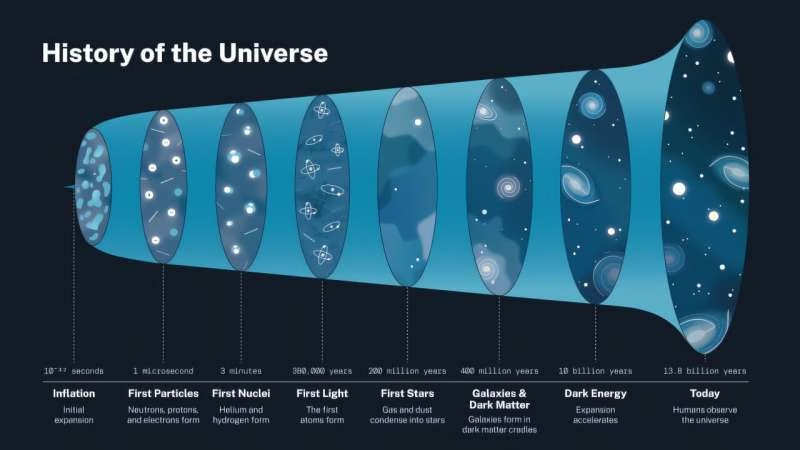According to researchers trying to solve the mystery of how the universe is expanding, dark energy, one of the biggest mysteries of science, does not actually exist. Their analysis was published in the journal Monthly Notices of Letters of the Royal Astronomical Society. For the last 100 years, physicists have generally assumed that space expands equally in all directions. They used the concept of dark energy as a placeholder to explain unknown physics they couldn’t understand, but the controversial theory always had problems.
Now a team of physicists and astronomers from the University of Canterbury in Christchurch, New Zealand, is challenging the status quo by using improved analysis of supernova light curves to show that the universe is expanding in a more diverse, “knobby” way.
New evidence supports a “timescape” model of cosmic expansion that does not require dark energy; because differences in the stretching of light are not the result of the universe accelerating, but instead a result of how we calibrate time and distance. It takes into account that gravity slows down time, so a perfect clock in empty space would tick faster than one inside a galaxy.
The model suggests that the clock in the Milky Way will be about 35 percent slower than the same clock at its average location in the vast voids of space, meaning billions more years will pass in the voids. This would allow space to expand further, giving the impression that the expansion is faster as such large empty voids grow to dominate the universe. Professor David Wiltshire, who led the research, said: “Our findings show that we do not need dark energy to explain why the universe appears to be expanding at an ever-increasing rate.
“Dark energy is actually an inaccurate description of changes in the kinetic energy of expansion that are not uniform in a universe as lumpy as the one we live in.”
He added: “The study provides compelling evidence that could answer some fundamental questions about the properties of our expanding universe.
“Thanks to new data, the universe’s greatest mystery could be solved by the end of the decade.”
Dark energy is generally thought of as a weak anti-gravity force that acts independently of matter and is about two-thirds the mass-energy density of the universe. The Standard Lambda Cold Dark Matter Model (ΛCDM) of the Universe requires dark energy to explain the observed acceleration of the expansion rate of the universe. Scientists base this conclusion on measurements of the distances to supernova explosions in distant galaxies; these distances appear further away than they would be if the expansion of the universe had not accelerated. However, the current expansion rate of the universe is increasingly questioned by new observations.
Also read – JWST telescope confirms expansion of universe is accelerating
First, evidence of the Big Bang’s afterglow, known as the cosmic microwave background (CMB), shows that the expansion of the early universe is at odds with the current expansion; this anomaly is known as the “Hubble voltage”.
In addition, a recent analysis of new high-precision data using the Dark Energy Spectroscopic Instrument (DESI) found that the ΛCDM model does not fit as well as models in which dark energy “evolves” over time rather than remaining constant. Both the Hubble stress and the surprises detected by DESI are difficult to resolve in models using the Friedman equation, the simplified 100-year law of cosmic expansion.
This suggests that, on average, the universe is expanding at a uniform rate; as if all cosmic structures could be put through a blender to make a vague soup with no complex structure. However, the current universe actually contains a complex cosmic network of galactic clusters in sheets and threads, surrounding and permeating vast empty spaces.
Professor Wiltshire added: “We now have so much data that in the 21st century we can finally answer the question: How and why does a simple law of mean expansion emerge from complexity?”
“A simple expansion law consistent with Einstein’s theory of general relativity should not obey the Friedman equation.”
The European Space Agency’s Euclid satellite, due to launch in July 2023, can test and distinguish the Friedman equation from the time-scape alternative, researchers say. However, this requires at least 1000 independent high-quality observations of supernovae.
When the proposed timescale model was last tested in 2017, analysis showed that it was only slightly better than ΛCDM as an explanation of cosmic expansion; So the Christchurch team worked closely with the Pantheon+ team, who meticulously created a catalog of 1,535 different supernovae. . They say the new data now provides “very strong evidence” for Timescape. This could also point to a convincing solution to the Hubble stress problem and other anomalies associated with the expansion of the universe.
While the race to use this wealth of new data to reveal the true nature of cosmic expansion continues, follow-up observations from the Euclid and Nancy Grace Rome Space Telescope are needed to strengthen support for the temporal landscape model, the researchers say. dark energy.













